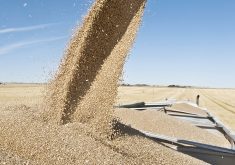Fed cattle prices fell last week because of ample supplies and sluggish beef demand.
Canfax said average prices were down $1.50-$2.50 per hundredweight with older yearling cattle consistently at the bottom end of the price range.
Prices in Alberta on March 26 were steers $77.25-$82.75 per cwt. and heifers $78.25-$81.55.
Canfax said beef buyers have good supplies and are forcing down wholesale beef prices going into Easter when other meats predominate.
Fed cattle prices are expected to remain under pressure, increasing the chance of backing up the system again as feeders hold back cattle hoping for better returns.
Read Also

Soybean market still figuring out implications of China-U.S. pact
Soybean futures had a muted reaction to the U.S. trade deal with China as the market tries to figure out the nuances of the deal.
Canfax’s outlook for this week was for yearlings to draw less than $80 per cwt. and calves just over $80.
In the western cow trade, average prices improved about $1 per cwt. due to fewer cow kills in Canada and the United States and strong boneless beef prices. The outlook is for steady prices.
In the feeder market, light cattle prices held steady, but heavier weight classes were $1-$2 per cwt. lower on average. The volume was down 20 percent from the previous week.
The outlook is for steady prices on cattle bound for grass, but lower on feedlot-ready types.
The stock cow market saw bred cow prices mostly $750-$1,050, bred heifers $850-$1,050 and cow-calf pairs $850-$1,100.
Hog prices rise and fall
Live hog prices were in the $34.50-36 (U.S.) per cwt. range for most of the week. Manitoba Agriculture said average Manitoba index 100 prices (including premiums) rose to $133 per 100 kilograms on March 23, but fell to below $130 by March 26.
SPI Marketing Group will no longer be the sole marketer of Saskatchewan hogs after April 1, but whether this will have any impact on the number of hogs sold to Manitoba plants remains to be seen.
The United States Department of Agriculture hog inventory report released March 27 (see table below) confirmed there will be a lot of pork around this year, and depressed prices will be the norm.
Taiwan is expected to buy 12,500 tonnes of U.S. pork (about two percent of total 1997 U.S. pork exports) after June 1, which will help use the excess pork.














